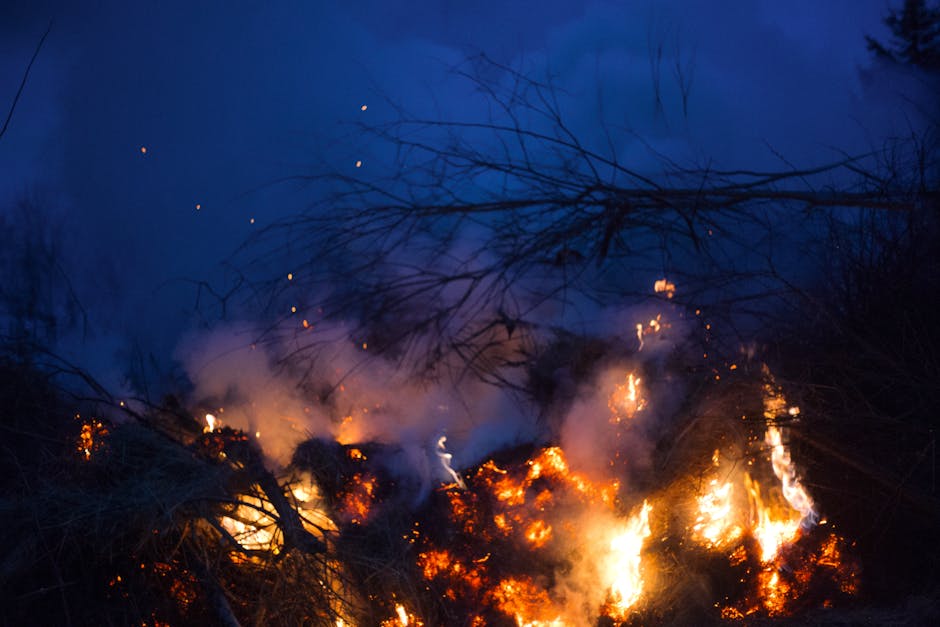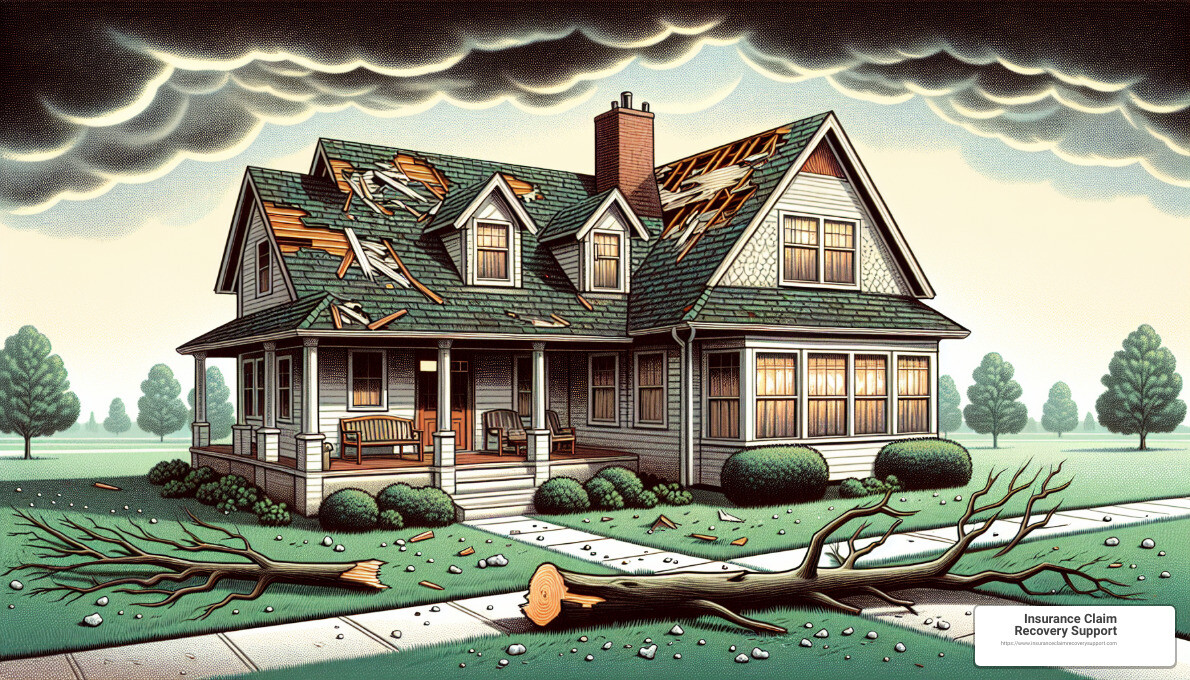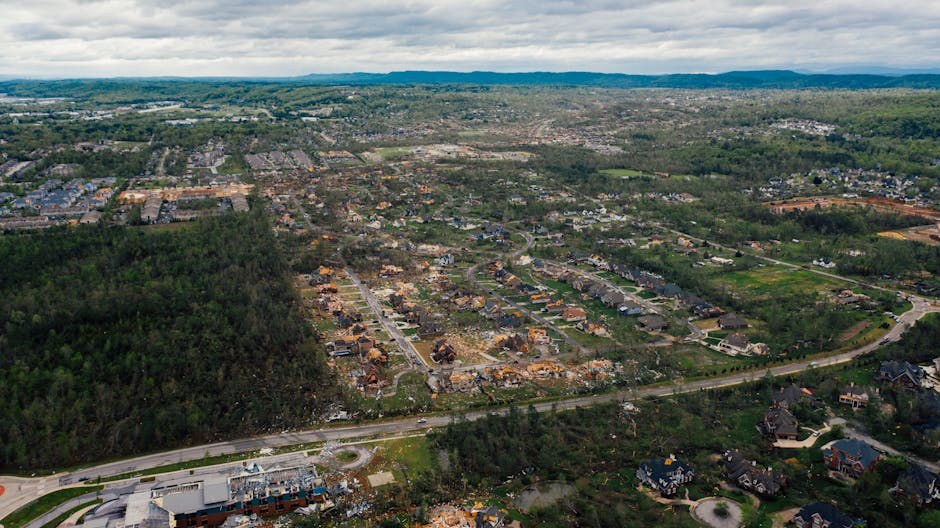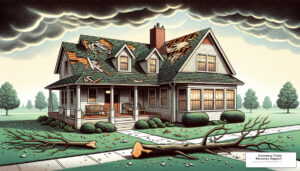When your property suffers fire damage, it’s not just the immediate destruction that’s concerning. An invisible threat, asbestos, can pose serious health risks after the fire. This risk is particularly high in older buildings. Asbestos fibers, when disturbed by the fire and subsequent cleanup, can become airborne and, if inhaled, may lead to serious health conditions, including cancer.
Quick Guide for Property Owners:
– Immediate Risks: Asbestos fibers can become airborne during and after a fire.
– Health Implications: Inhalation of asbestos can cause diseases like mesothelioma and lung cancer.
– First Steps: Avoid entering the damaged property until professionals have deemed it safe.
By understanding the risks and taking the right precautions, you can protect yourself, your tenants, or your employees from asbestos exposure.

Fires in buildings pose not just an immediate threat to structure and property, but also long-term health implications due to the potential presence and release of asbestos. Older constructions are especially vulnerable, as asbestos was commonly used for its fire-resistant properties until its dangers became widely acknowledged. Once a fire has damaged a property, the asbestos within building materials can be released into the air as fine, inhalable fibers. These fibers, when inhaled, can lead to chronic and life-threatening diseases such as mesothelioma, lung cancer, and asbestosis. Therefore, safety in the aftermath of a fire not only involves securing the structure and salvaging what remains but also necessitates a keen awareness and proactive management of asbestos exposure risks.
Understanding Asbestos and Fire Damage
Let’s dive into a world that’s been hidden in our walls and ceilings for decades. Asbestos, a term that might sound like something from a history book, is more relevant to our lives than we might think, especially when it comes to fire damage.
A Quick History Lesson
Asbestos isn’t a new fad. It’s been around for thousands of years, used for its fire-resistant superpowers. People from as far back as Ancient Greece wrapped their dead in it, believing its indestructible nature would protect the essence of their loved ones. Fast forward to the industrial era, and asbestos became the go-to material for building almost everything you can think of – from insulation to floor tiles.
Why Was Asbestos Used in Buildings?
Simply put, asbestos is like that superhero that doesn’t burn in fire. Its fibers are strong, resistant to heat, and don’t catch fire easily. This made it an attractive option for making homes and buildings safer. Plus, it was cheap and abundant, which are two things that usually make materials popular in construction.
The Turn of Events: EPA Ban
Everything changed in 1989 when the U.S. Environmental Protection Agency (EPA) put its foot down and banned all new uses of asbestos. Why? Because, despite its superhero qualities, asbestos had a dark side. When its fibers are inhaled, they can cause serious diseases like mesothelioma, a type of cancer that can be fatal.
But here’s the kicker – the ban didn’t apply to materials that already contained asbestos. That means if your home was built or renovated before the 1990s, there’s a good chance it might contain asbestos.
Asbestos and Fire Damage
When a fire hits a building, it’s not just the flames that are dangerous. If asbestos materials get damaged, they can release tiny, invisible fibers into the air. These fibers can travel with smoke and spread far from the fire site. Breathing them in is harmful and can lead to serious health problems down the line.
So, when we talk about ‘asbestos after a fire’, we’re not just talking about the immediate cleanup. We’re talking about protecting ourselves and our loved ones from invisible dangers that could affect our health years after the fire has been extinguished.
Wrapping Up
Understanding the risks associated with asbestos, especially after a fire, is crucial. While asbestos might be a thing of the past in terms of its use in new buildings, its legacy lives on in older structures. Recognizing this and taking appropriate actions after a fire can make all the difference in safeguarding our health.
Remember that staying safe from asbestos after a fire isn’t just about cleaning up. It’s about being informed, cautious, and proactive in dealing with the aftermath.
Immediate and Long-Term Health Risks
When we talk about asbestos after a fire, it’s crucial to understand the health risks this poses, not just immediately but also in the long run. Let’s dive into the main conditions linked to asbestos exposure: Mesothelioma, lung cancer, asbestosis, and pleural thickening. Plus, we’ll touch on the latency period, which is the time between exposure and the onset of symptoms.
Mesothelioma
This is a rare but aggressive cancer that affects the lining of the lungs, abdomen, or heart. It’s directly linked to asbestos exposure. Studies, including one from 2013, showed firefighters, who are often exposed to asbestos in fires, have twice the rate of mesothelioma compared to the general population. This highlights the serious risk asbestos poses, even to professionals trained to deal with such hazards.
Lung Cancer
Asbestos exposure can also lead to lung cancer, a condition where malignant cells form in the lung’s tissues. It’s a leading cause of cancer-related deaths worldwide, and asbestos significantly increases this risk. There’s no safe level of asbestos exposure; even small amounts can be harmful.
Asbestosis
This chronic lung disease is caused by inhaling asbestos fibers, leading to lung scarring and stiffness. Symptoms include shortness of breath and a persistent, dry cough. Over time, asbestosis can severely impair lung function, making it difficult for those affected to breathe.
Pleural Thickening
Another condition resulting from asbestos exposure is pleural thickening. This is when the lining of the lung (pleura) becomes scarred, thickening and restricting lung expansion. It can cause breathlessness and significantly impact the quality of life.
Latency Period
One of the most challenging aspects of asbestos-related diseases is the latency period. It can take anywhere from 10 to 40 years for symptoms to appear after exposure. This delay often means that conditions are advanced and more difficult to treat by the time they’re diagnosed.
Understanding these risks underscores the importance of taking immediate and effective action after a fire to minimize asbestos exposure. It’s not just about the immediate aftermath; it’s about protecting your health years down the line. Always rely on professionals for asbestos abatement and follow safety guidelines strictly if you must handle materials before help arrives.
As we move into discussing how to identify asbestos in fire-damaged homes, keep these health risks in mind. It’s not just about property damage; it’s about protecting your and your family’s health from the invisible threat of asbestos after a fire.
Identifying Asbestos in Fire-Damaged Homes
When a fire strikes, the immediate focus is on the visible damage. However, the invisible threat of asbestos after a fire can pose long-term health risks. Identifying the presence of asbestos is a crucial step in ensuring the safety of everyone involved. Let’s break down how to spot and deal with asbestos in your home after a fire.
Pre-1990 Construction
If your home was built or renovated before 1990, there’s a higher chance it contains asbestos. The material was widely used in various building products for its fire-resistant properties. Knowing the age of your home can be a quick indicator of potential asbestos presence.
Common Asbestos Materials
Asbestos could be lurking in many places within your home. Common materials include:
- Insulation: Often found in attics, walls, and around pipes.
- Floor and ceiling tiles: Used for their durability and fire-resistant qualities.
- Textured paint and patching compounds: Applied on walls and ceilings.
- Roofing and siding shingles: Made with asbestos for strength and fire resistance.
These are just a few examples. Asbestos was hailed as a wonder material and used in numerous home construction products.
Visual Inspection
A visual inspection can sometimes help identify materials that typically contain asbestos, but it’s not foolproof. Asbestos fibers are too small to be seen with the naked eye, and many asbestos-containing materials (ACMs) look identical to non-asbestos alternatives. If you notice damaged building materials that could potentially contain asbestos, treat them with caution.
Professional Testing
The only surefire way to determine if your home contains asbestos is through professional testing. This involves:
- Hiring a certified asbestos inspector: They will collect samples of suspected materials in a safe manner.
- Laboratory analysis: The samples are analyzed to confirm the presence and type of asbestos.
Professional testing is essential, not just for peace of mind, but also for guiding the safe cleanup and abatement process. Disturbing asbestos-containing materials can release harmful fibers into the air, increasing the risk of exposure.
Understanding the importance of professional help for asbestos abatement post-fire cannot be overstated. While identifying potential asbestos in your home is a critical first step, ensuring its safe removal is paramount to maintaining a healthy living environment.
Safe Cleanup and Asbestos Abatement Post-Fire
After a fire, the priority shifts to cleanup and rebuilding. However, if your home was built before 1990, there’s a good chance asbestos materials are present and were disturbed during the fire. Here’s how to tackle asbestos safely post-fire.
Professional Abatement
First and foremost, professional abatement is the safest route to take. Professionals have the tools, knowledge, and protective gear to handle asbestos without spreading harmful fibers. They follow strict regulations to ensure the asbestos is safely removed and disposed of, minimizing the risk to you, your family, and the environment.
DIY Precautions
If you’re considering handling the cleanup yourself, think twice. Asbestos fibers are invisible and can easily be inhaled. However, if there are minor tasks you feel compelled to undertake, follow these precautions:
- Wear Protective Gear: A high-quality respirator mask (N-100 or P-100), gloves, and disposable coveralls are non-negotiable.
- Keep Asbestos Wet: This helps prevent fibers from becoming airborne.
- Avoid Using Power Tools: These can release more fibers into the air.
- Seal Off the Area: Use plastic sheeting to contain the work area.
DIY is not recommended for asbestos. The risks far outweigh the potential savings.
Protective Gear
Whether you’re a professional or a homeowner taking immediate, small-scale action, protective gear is a must. Use a NIOSH-approved N-100 or P-100 respirator, gloves, and disposable coveralls. Safety first, always.
Legal Disposal
Asbestos waste must be disposed of according to state and federal regulations. This usually means taking it to a certified landfill equipped to handle hazardous materials. In Texas, for example, you must follow specific Texas regulations for asbestos disposal, including filing the necessary paperwork and ensuring the waste is transported and disposed of properly.
Texas Regulations
In Texas, the handling, removal, and disposal of asbestos are governed by strict regulations to protect public health and safety. Before any demolition or renovation:
- An inspection must be done by a licensed asbestos inspector.
- If asbestos is found, removal must be performed by a licensed abatement professional.
- Asbestos waste must be properly labeled and disposed of at an approved facility.
Following these steps not only keeps you safe but also ensures you’re compliant with state laws, avoiding potential fines.
Moving Forward
Asbestos after a fire poses significant health risks, but with the right approach, these risks can be managed. Opting for professional abatement, using protective gear for any direct contact, and following legal disposal protocols are key steps in ensuring a safe cleanup process. Cutting corners when dealing with asbestos is not worth the risk to your health or the environment.
By understanding and implementing these safety measures, you’re not only protecting yourself but also contributing to the overall safety and well-being of your community.
Preventing Asbestos Exposure After a Fire
After a fire, the dangers don’t end with the flames. Asbestos, a harmful material once widely used in construction, can pose serious health risks if it’s disturbed and released into the air. Here’s how you can prevent asbestos exposure after a fire.
Avoiding Contamination
The first step in avoiding asbestos contamination is to recognize the potential danger. If your home was built before 1990, it’s wise to assume that asbestos materials may be present. After a fire, it’s crucial to keep a safe distance from the damaged area until professionals can assess the situation. Asbestos fibers are too small to see and can stay in the air for days.
Protective Clothing
If you must enter a fire-damaged area, wearing protective clothing is essential. This includes:
- A mask (N-100 or P-100 respirators are recommended)
- Gloves
- A long-sleeved shirt and long pants
- Closed-toe shoes
This gear helps prevent asbestos fibers from attaching to your skin or clothes.
Treating Materials as Contaminated
In fire-damaged buildings, it’s safest to treat all materials as if they’re contaminated with asbestos. This approach minimizes your risk of exposure. Don’t attempt to move, clean, or disturb debris on your own. The microscopic fibers released can be harmful to your health.
Professional Cleanup
The safest way to deal with asbestos after a fire is to hire state-certified professionals. These experts have the training and equipment to safely remove asbestos materials and decontaminate the area. They know how to properly package and dispose of the waste, ensuring that it doesn’t pose a health risk to others.
A fire’s aftermath is a critical time for safety. By following these guidelines, you can protect yourself and your family from asbestos exposure. Don’t take chances with your health. Let the professionals handle the cleanup, and focus on your recovery and rebuilding efforts.
In the next section, we’ll answer some frequently asked questions about asbestos after a fire.
Frequently Asked Questions about Asbestos After a Fire
When dealing with the aftermath of a fire, concerns about asbestos exposure can add to the stress. Here, we address some common questions to help you understand the risks and the right steps to take.
Can one-time exposure to asbestos in a fire be harmful?
Yes, even a one-time exposure to asbestos can be harmful. While the risk increases with prolonged exposure, there’s no known safe level of asbestos exposure. Asbestos fibers, when inhaled, can lodge in the lungs and potentially lead to serious health issues, including mesothelioma, lung cancer, and asbestosis. It’s crucial to minimize your exposure as much as possible.
How long do asbestos fibers stay airborne after a fire?
Asbestos fibers are incredibly lightweight and can remain airborne for hours or even days after a disturbance, such as a fire. The duration these fibers stay suspended in the air depends on several factors, including the size of the fibers, air currents, and the extent of the disturbance. Because of their tiny size, asbestos fibers can easily be inhaled without realizing, making them particularly dangerous.
What should I do if I suspect asbestos exposure after a fire?
If you suspect that you’ve been exposed to asbestos after a fire, it’s important to take immediate steps:
- Avoid further exposure: Stay away from the affected area until it has been professionally assessed and cleaned.
- Consult a doctor: Inform your healthcare provider about the potential exposure. They can recommend any necessary medical examinations to monitor your health.
- Contact professionals: Reach out to a certified asbestos abatement company to handle the cleanup and disposal of asbestos materials. They have the expertise and equipment to safely remove asbestos without further contaminating the environment or exposing individuals to risk.
- Report and document: If the fire occurred in a workplace or public building, report the incident to the appropriate authorities. Keep a record of your exposure and any health-related information for future reference.
The best approach to dealing with asbestos after a fire is prevention and professional intervention. Handling asbestos-containing materials on your own can increase the risk of exposure for you and others.
In conclusion, staying informed and cautious can significantly reduce the risks associated with asbestos exposure following a fire. If you have more questions or need assistance, don’t hesitate to reach out to professionals who specialize in asbestos abatement and fire damage recovery.
Conclusion
When facing the aftermath of a fire, the safety and health of you and your loved ones should always be the top priority. As we’ve explored, dealing with asbestos after a fire presents unique challenges and risks. It’s crucial to approach the situation with a high degree of awareness and caution.
Health safety isn’t just about immediate actions; it’s about ensuring long-term well-being. Asbestos-related diseases can take years to manifest, making it all the more important to handle asbestos exposure with the seriousness it demands. Whether you’re a homeowner, a renter, or a first responder, understanding the risks and knowing how to mitigate them is key.
This is where professional assistance becomes invaluable. Asbestos abatement and fire recovery are complex processes that require specialized knowledge and equipment. Attempting to tackle these tasks on your own can not only be ineffective but can also exacerbate the risk of exposure for you and others. Professionals are equipped to safely assess, contain, and remove asbestos-containing materials, ensuring that the environment is safe for you and your family to return to.
At Insurance Claim Recovery Support LLC, we understand the complexities and dangers involved in dealing with asbestos after a fire. Our team is committed to assisting you through every step of the recovery process. From identifying potential asbestos risks to navigating the insurance claims process, we are here to ensure that you receive the support and compensation you deserve. Our expertise in handling fire property damage claims means that you can focus on recovery and rebuilding, knowing that the technical and legal aspects are in capable hands.
You’re not alone in this. Insurance Claim Recovery Support LLC is here to guide you through this difficult time, ensuring your safety and helping you recover what you are entitled to from your insurance claim. Stay informed, stay safe, and don’t hesitate to reach out for professional assistance.
Facing a fire-damaged property can be overwhelming, especially when dealing with the added complication of asbestos. However, with the right awareness and by seeking professional help, these challenges can be managed effectively. Let us help you navigate this journey, ensuring a safer and smoother path to recovery.









